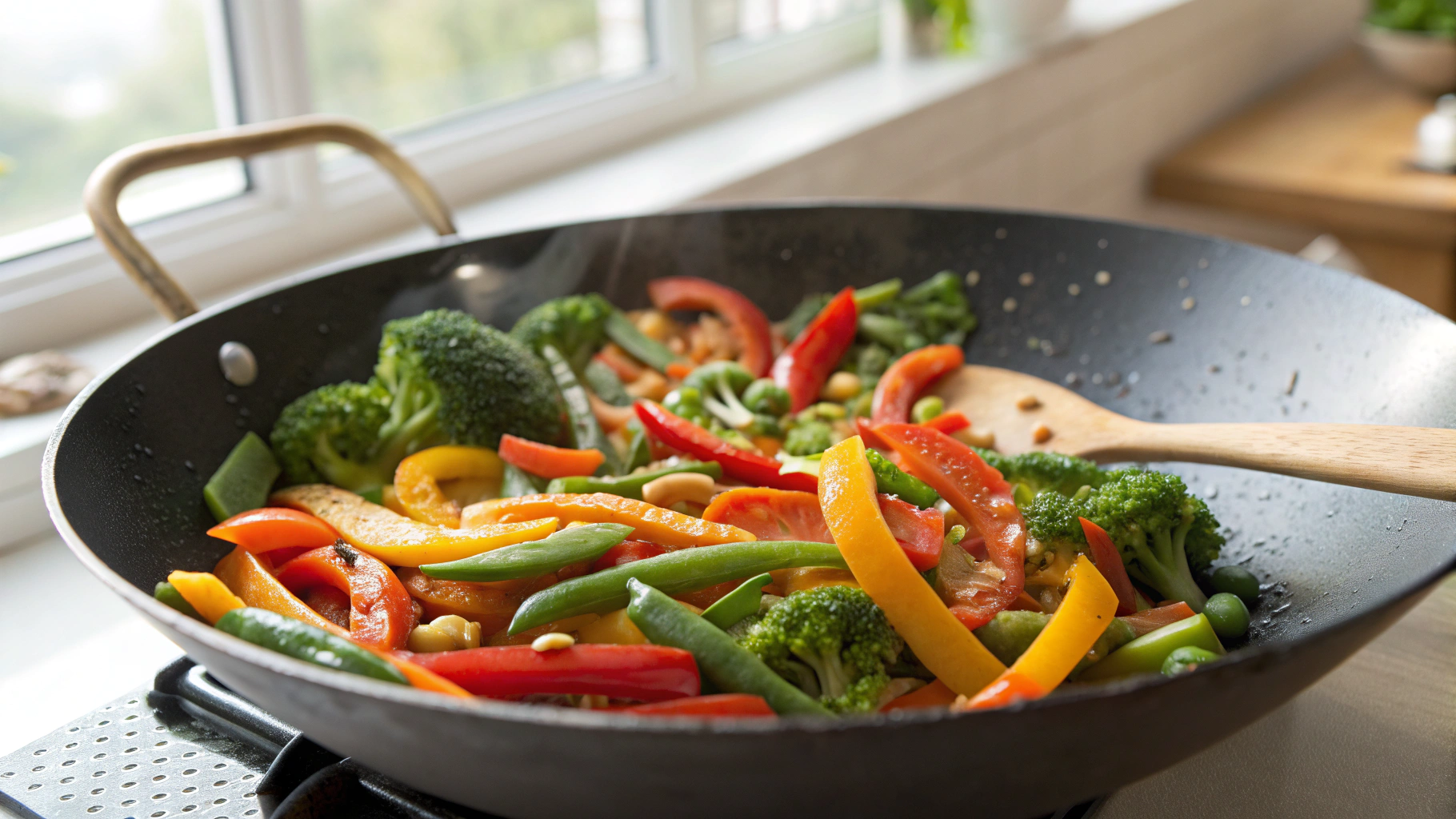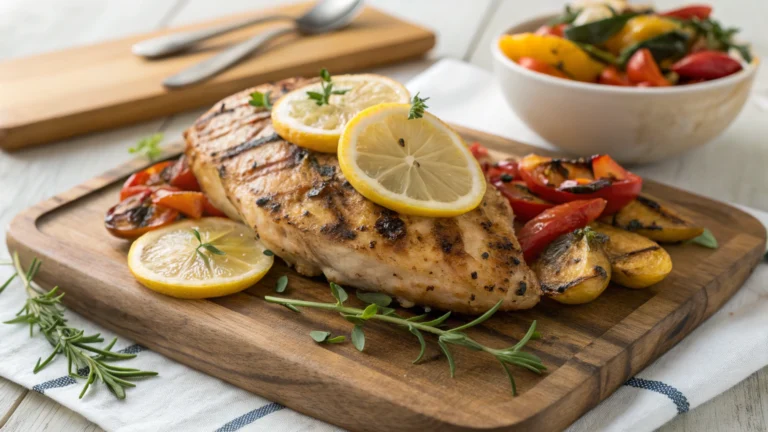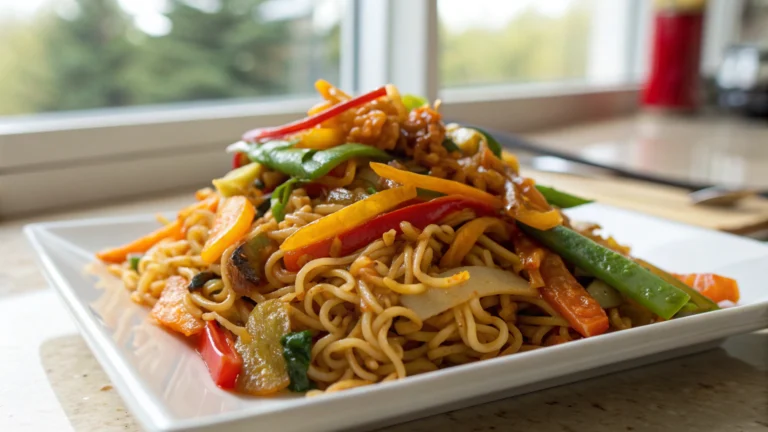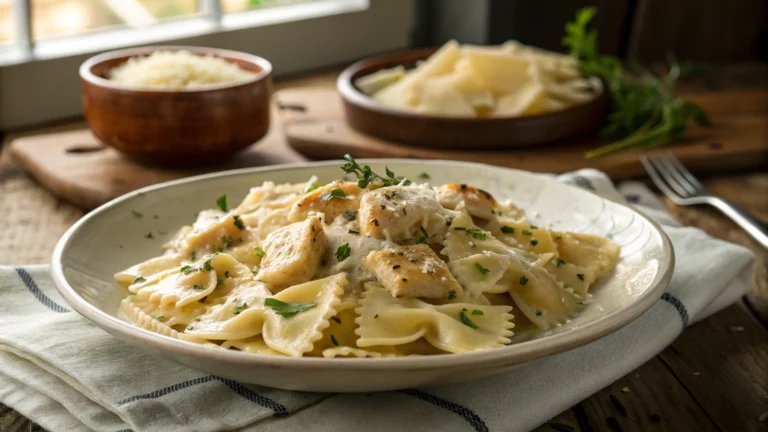Vegetable Stir Fry
Introduction
There’s something deeply satisfying about whipping up a colorful vegetable stir fry at the end of a long day. The sizzle in the pan, the aroma of garlic and ginger, the way each vegetable keeps its bite — it’s my kind of comfort food. I love that it’s endlessly customizable, incredibly fast to prepare, and always leaves me feeling like I’ve eaten something nourishing and good.
Why choose this Vegetable Stir Fry recipe?
This recipe came from a desire to eat more vegetables without sacrificing flavor. Over the years, I’ve played around with different sauces, protein add-ins, and cooking techniques, but this version is my favorite go-to. Whether you’re clearing out the fridge or craving a light yet flavorful meal, this vegetable stir fry delivers every time.
Ingredients for Vegetable Stir Fry
- Broccoli florets – Adds crunch, color, and a nutrient boost with fiber and vitamins.
- Bell peppers (red, yellow, or green) – Their sweetness balances the savory sauce and adds visual appeal.
- Carrots – Thinly sliced carrots bring a subtle sweetness and great texture contrast.
- Snow peas or snap peas – Add a delightful crispness and natural sweetness.
- Mushrooms (optional) – Provide an earthy flavor and meaty texture that deepens the overall taste.
- Garlic and ginger – Essential aromatics that infuse the stir fry with depth and warmth.
- Green onions – Fresh, sharp flavor that brightens the dish at the end.
- Soy sauce – The salty, umami-rich base of the sauce.
- Hoisin sauce or oyster sauce – Adds complexity and a touch of sweetness.
- Sesame oil – A small amount goes a long way in adding nutty richness.
- Cornstarch and water slurry – Thickens the sauce so it coats the vegetables perfectly.
- Oil for cooking (like canola or vegetable oil) – Neutral in flavor and has a high smoke point, ideal for stir-frying.
- Cooked rice or noodles (optional for serving) – Soaks up the flavorful sauce and rounds out the meal.
Preparation Steps for Vegetable Stir Fry

Step 1: Prep All the Vegetables
Wash and chop all your vegetables into uniform, bite-sized pieces. This ensures even cooking and a pleasant eating experience. Have everything ready before turning on the heat — stir-frying is fast, and you won’t have time to chop mid-cook.
Step 2: Mix the Stir Fry Sauce
In a small bowl, whisk together soy sauce, hoisin or oyster sauce, a splash of water, and a teaspoon of sesame oil. If you’d like it a bit spicy, add some red pepper flakes or a squirt of sriracha. Stir in the cornstarch slurry last to help thicken the sauce when cooking.
Step 3: Heat the Pan
Heat a wok or large skillet over medium-high heat until it’s hot. Add oil and swirl to coat. When the oil starts to shimmer, it’s time to cook.
Step 4: Stir Fry the Aromatics
Toss in the garlic and ginger. Stir constantly for 30 seconds — just until fragrant. Be careful not to burn them.
Step 5: Cook the Vegetables
Start with the firmest vegetables like carrots and broccoli, cooking for about 2–3 minutes. Then add the quicker-cooking ones like bell peppers, peas, and mushrooms. Keep the veggies moving in the pan to avoid steaming and ensure they stay crisp-tender.
Step 6: Add the Sauce
Pour the sauce over the vegetables and toss everything to coat evenly. Cook for another 1–2 minutes until the sauce thickens and everything is glossy.
Step 7: Finish and Serve
Remove from heat and stir in green onions. Serve.
Health Benefits of Vegetable Stir Fry
Vegetable stir fry is not only a delicious dish but also a healthy choice for your diet. Packed with a variety of colorful and nutritious vegetables, this dish offers a range of health benefits. The high fiber content in vegetables can aid in digestion and help maintain a healthy weight. The vitamins and minerals present in the vegetables can boost your immune system and overall well-being. Additionally, stir frying vegetables helps retain their nutrients better than other cooking methods, ensuring you get the maximum nutritional value from your meal.
Origin and History of the Vegetable Stir Fry Recipe
The vegetable stir fry recipe has its roots in traditional Chinese cooking techniques. Stir frying, which involves cooking ingredients quickly over high heat, has been a staple in Chinese cuisine for centuries. The method was developed as a way to preserve the natural flavors, textures, and nutritional content of the ingredients. Over time, stir fry recipes have evolved to incorporate a wide range of vegetables, seasonings, and sauces, reflecting different regional and cultural influences. Today, vegetable stir fry has become a popular and versatile dish enjoyed in households around the world.
Delicious Variations Around Vegetable Stir Fry
While the classic vegetable stir fry recipe is delicious on its own, there are endless possibilities for creating unique and flavorful variations. You can experiment with different vegetable combinations, sauces, and seasonings to customize the dish to your taste preferences. Some popular variations include adding protein sources like tofu, shrimp, or chicken, incorporating exotic vegetables such as baby corn or water chestnuts, or trying out alternative sauces like teriyaki or peanut sauce. By exploring various ingredients and flavors, you can create a vegetable stir fry that suits your palate and culinary creativity.
Chef’s Tips for Perfecting Your Vegetable Stir Fry
To elevate your vegetable stir fry and achieve the perfect balance of flavors and textures, consider the following tips from culinary experts:
- Ensure your vegetables are cut into uniform sizes for even cooking.
- Prep and organize all your ingredients before starting to stir fry to maintain a smooth cooking process.
- Use high-quality sauces and seasonings to enhance the taste of your dish.
- Avoid overcrowding the pan to allow the vegetables to cook quickly and retain their crispness.
- Experiment with different cooking oils like sesame oil or peanut oil for added depth of flavor.
- Garnish your stir fry with fresh herbs or nuts for a final touch of freshness and crunch.
Ingredient Alternatives for Vegetable Stir Fry
When it comes to making a delicious vegetable stir fry, there are endless possibilities for ingredient substitutions to suit your preferences or dietary needs. Here are a few ideas to inspire your culinary creativity:
- Protein Options: Instead of tofu or meat, you can try adding chickpeas, tempeh, or seitan for a plant-based protein boost.
- Vegetable Variations: Experiment with different veggies like bok choy, asparagus, water chestnuts, or edamame to introduce new textures and flavors.
- Sauce Varieties: Explore using teriyaki sauce, coconut aminos, or a homemade peanut sauce for a unique twist on traditional stir fry flavors.
- Grain Substitutes: For a gluten-free option, serve your vegetable stir fry over quinoa, buckwheat noodles, or spiralized vegetables like zucchini or sweet potato.
Tips and Tricks to Perfect Your Vegetable Stir Fry
Mastering the art of vegetable stir fry requires a few key techniques to ensure your dish turns out flavorful and well-balanced. Here are some expert tips to help you elevate your stir fry game:
- Hot Pan, Quick Cook: Heat your pan or wok thoroughly before adding ingredients to achieve that signature stir fry sear and prevent veggies from becoming soggy.
- Prep Ahead of Time: Chop and measure all your ingredients before you start cooking to streamline the process and avoid overcooking any components.
- Layer Flavors: Add ingredients in stages based on their cooking times to ensure each component retains its individual taste and texture.
- Bold Seasonings: Don’t be shy with seasonings like garlic, ginger, and soy sauce to infuse your stir fry with depth of flavor.
Side Dish Suggestions for Vegetable Stir Fry
Pairing your vegetable stir fry with complementary side dishes can take your meal to the next level. Here are some delicious accompaniments that perfectly complement the flavors and textures of a vegetable stir fry:
- Steamed Jasmine Rice: Serve your stir fry over fluffy jasmine rice to soak up the savory sauce and add a comforting element to the meal.
- Crispy Spring Rolls: Crispy vegetable spring rolls make a delightful crunchy side dish that contrasts beautifully with the tender stir fry veggies.
- Asian Slaw: A refreshing and crunchy Asian slaw with a sesame-ginger dressing provides a light and vibrant counterpart to the rich flavors of the stir fry.
- Garlic Butter Noodles: Indulge in a bowl of garlic butter noodles for a decadent and satisfying side that complements the umami notes of the stir fry.
FAQ about the recipe Vegetable Stir Fry
How to store the recipe Vegetable Stir Fry after cooking?
To store the Vegetable Stir Fry, ensure it has cooled to room temperature before transferring it to an airtight container. Place it in the refrigerator, where it can stay fresh for up to 3 days. When reheating, a quick stir fry in a hot pan can revive the flavors and textures.
Can the recipe Vegetable Stir Fry be prepared in advance?
Yes, you can prepare the Vegetable Stir Fry in advance to save time. Complete the cooking process as usual, then let it cool before refrigerating in an airtight container. When ready to eat, simply reheat it in a pan over medium heat, adding a splash of water or sauce to refresh the dish.
What ingredients can be substituted in the recipe Vegetable Stir Fry?
If you need to substitute ingredients in the Vegetable Stir Fry, feel free to swap vegetables based on what you have available. For a different flavor profile, you can replace soy sauce with tamari or hoisin sauce with oyster sauce. Protein options like tofu, seafood, or meat can be interchanged according to your preferences.
How to adapt the recipe Vegetable Stir Fry for a vegetarian version?
To adapt the Vegetable Stir Fry for a vegetarian version, simply omit any meat-based ingredients and focus on using a variety of vegetables for texture and flavor. Tofu can be a great protein substitute, absorbing the delicious sauce. Ensure to use vegetarian-friendly sauces and check labels for hidden animal products.
Is the recipe Vegetable Stir Fry suitable for children?
Indeed, the Vegetable Stir Fry can be a child-friendly dish, offering a colorful array of vegetables that can be appealing to kids. To make it more kid-friendly, you can adjust the spice levels, cut the vegetables into smaller, bite-sized pieces, and involve children in the cooking process to encourage them to try new foods.
Conclusion about the recipe Vegetable Stir Fry
In conclusion, the Vegetable Stir Fry recipe stands out as a versatile and flavorful dish that caters to various preferences and dietary needs. Whether you’re a vegetable enthusiast, looking for a quick weeknight meal, or aiming to introduce more plant-based options into your diet, this stir fry offers a delightful culinary experience with every bite.
📌 Keep This Recipe Handy & Discover More Tasty Ideas!
Enjoyed this recipe? Don’t let it slip away! Save it now on Pinterest so it’s always just a click away. Pinning it also helps others find simple, delicious meal ideas!
💡 Whether you’re organizing your weekly meal plan or whipping up something special for guests, having your go-to recipes saved makes life in the kitchen so much easier. Use Pinterest to collect your favorites, explore new versions of classic dishes, and revisit your top meals anytime.
📲 Don’t forget to follow us on Pinterest for a daily dose of inspiration — from cozy family dinners and quick lunches to seasonal desserts and healthy snacks. We update regularly with recipes designed to fit your lifestyle and taste.
📖 Craving more? Head over to our full recipe library to browse a wide variety of easy and flavorful dishes. No matter your skill level, you’ll find recipes that are simple to make and packed with flavor.
✨ Bookmark your favorites and swing by often — there’s always something fresh and delicious waiting for you!





